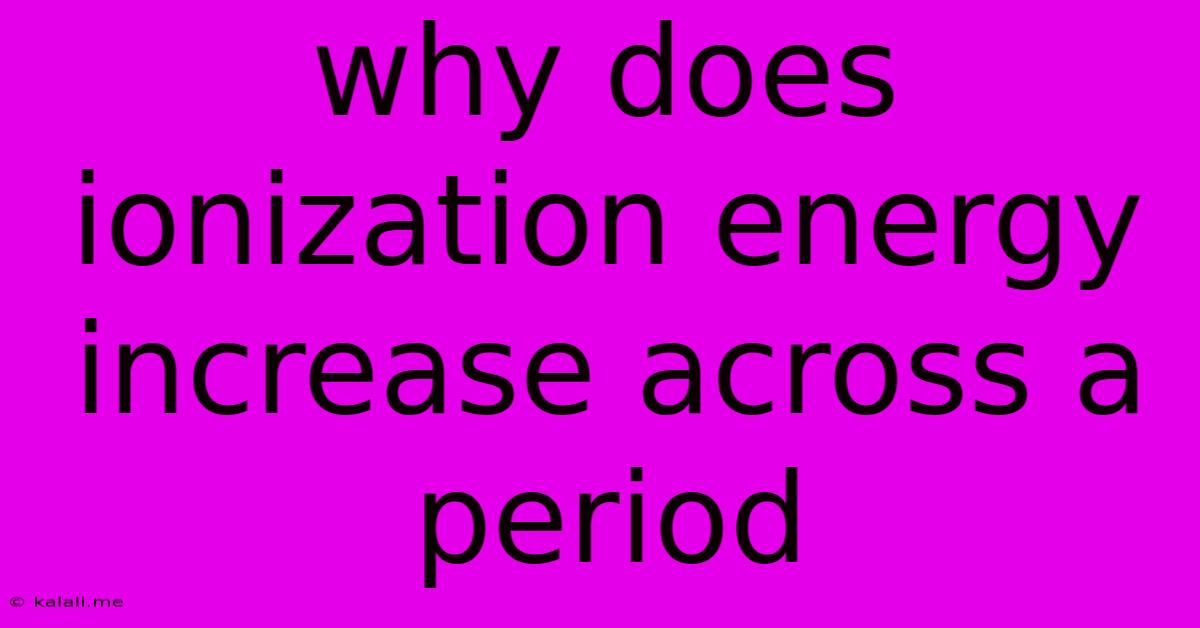Why Does Ionization Energy Increase Across A Period
Kalali
May 25, 2025 · 3 min read

Table of Contents
Why Does Ionization Energy Increase Across a Period? A Deep Dive into Atomic Structure
Meta Description: Understanding why ionization energy increases across a period requires exploring the relationship between atomic structure, effective nuclear charge, and electron shielding. This article breaks it down simply.
Ionization energy, the energy required to remove an electron from a gaseous atom, exhibits a fascinating trend across the periodic table: it generally increases from left to right across a period. This isn't a random occurrence; it's a direct consequence of the fundamental principles governing atomic structure and electron behavior. Let's delve into the key reasons behind this increase.
The Role of Effective Nuclear Charge
The primary driver of the ionization energy trend is the effective nuclear charge (Z<sub>eff</sub>). This isn't the total positive charge of the nucleus, but rather the net positive charge experienced by the outermost electrons (valence electrons). As we move across a period, the number of protons in the nucleus increases, leading to a stronger positive charge. However, the number of shielding electrons in the inner shells remains constant within a period.
This means that the valence electrons are experiencing a greater pull from the nucleus – a higher Z<sub>eff</sub> – as we move across the period. This stronger attraction makes it harder to remove an electron, thus increasing the ionization energy. Think of it like this: the more positively charged the nucleus, the tighter it holds onto its electrons.
Shielding Effect: A Constant Factor Within a Period
The shielding effect refers to the reduction of the attractive force between the nucleus and the valence electrons due to the presence of inner electrons. These inner electrons effectively "shield" the outer electrons from the full positive charge of the nucleus. Crucially, within a single period, the number of inner shell electrons remains constant. Therefore, the shielding effect doesn't change significantly as we move across a period. This constancy highlights the dominant role of the increasing nuclear charge in driving the ionization energy trend.
Atomic Radius: A Decreasing Trend
Another contributing factor is the atomic radius, which generally decreases across a period. As the effective nuclear charge increases, the valence electrons are pulled closer to the nucleus, resulting in a smaller atom. This smaller atomic radius means the valence electrons are held more tightly, requiring more energy to remove them, further increasing ionization energy.
Exceptions and Anomalies
While the general trend is a clear increase in ionization energy across a period, there are some minor exceptions. These exceptions typically arise due to subtle variations in electron-electron repulsions or subtle differences in orbital stability. For example, the slight dip in ionization energy between Groups 2A (alkaline earth metals) and 3A (boron group) can be attributed to the increased electron-electron repulsion in the p-orbital compared to the filled s-orbital. The energy required to remove the first electron from a filled orbital (s-orbital in this case) is more significant.
In Summary
The increase in ionization energy across a period is primarily a consequence of the increasing effective nuclear charge (Z<sub>eff</sub>). As the number of protons increases without a corresponding increase in shielding electrons, the valence electrons experience a stronger attraction to the nucleus, making them harder to remove. The decreasing atomic radius across a period further contributes to this trend. While some minor exceptions exist, the overall pattern remains consistent and directly linked to the fundamental principles of atomic structure.
Latest Posts
Latest Posts
-
Why Does Xcom 2 Recommend Not Skipping Missions
May 26, 2025
-
Fallout 4 Companion Likes And Dislikes
May 26, 2025
-
Recordactiondeployment Looks Like The Flow Is Inactive
May 26, 2025
-
Shared Saints In The Orthodox And Catholic Church
May 26, 2025
-
What Is The Mac Version Of Ctrl Alt Delete
May 26, 2025
Related Post
Thank you for visiting our website which covers about Why Does Ionization Energy Increase Across A Period . We hope the information provided has been useful to you. Feel free to contact us if you have any questions or need further assistance. See you next time and don't miss to bookmark.